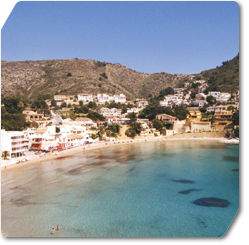- Villa search

- Canaries
- Caribbean
- Croatia, Bulgaria and Hungary
- Cyprus
- Florida
- France and Corsica
- Greece
- Italy
- Lakes and Mountains
- Madeira
- Malta and Gozo
- Portugal
- South Africa
- Spain - Balearics

Another beneficiary of the building boom is the harbour area, with its new fish market (computerised, with viewing galleries) and marina and yacht club. There is a string of fish restaurants, but the best fish is reckoned to be at Restaurant Baydal, set apart from the others. Recent expansion has left it with a rather canteen-like atmosphere, but the food remains good.
Sailing is popular in Calpe and the yachting school is the place to go if you want to brush up your skills or start from scratch. For experts, Ibiza is a popular destination – it’s a day’s sailing away.
The Peñon is now a nature reserve and, despite its formidable appearance, a walk to the top is straightforward enough if you are averagely fit, taking an hour or a little more. A tunnel carved through one cliff face takes you to the gentler slopes on the other side, but you still need to scramble in places – so be sure to have sensible footwear. The view from the top is stupendous.
If you fancy an easier option, a walk around part of the base of the Peñon has been carved from rock with the help of EU money. There are terrific views across the bay and in the spring you’ll see gulls standing guard by their nests, only feet from the promenaders.
The level walk from the start of the promenade in town to the end of the Peñon nature walk takes around an hour. Extend the excursion by stopping at Casita Belga, the best sea front café/restaurant in town, halfway between town and harbour.
The promenade is crying out to be lined with pine trees to make it prettier and cooler – particularly in high summer. Tree planting would also improve the view from the sea-front apartments along the promenade, one of which we stayed in – fabulous views across the bay, but the wide pavement below would look better with trees.
From the end of the promenade on Calpe’s eastern (Levante) beach you can carry on walking along the cliffs, past mature villas with good sea views, for some miles. And at the opposite end of the bay, another cliff walk takes you, via small coves, to three striking buildings, designed by architect Ricardo Bofill and built between the sixties and eighties.
Most wacky are the green Xanadu building and the Red Wall building (in pinks from dusky rose to terracotta). The Amphitheatre building comprises luxury homes on a site shaped like a classical amphitheatre. The pool, which extends down the cliff, occupies the space which, in Greek tradition, is called the 'stage' and frames the scenery. From here you can gaze at cliffs, a wide expanse of sea and – at its best glowing pink in the evening light – the Peñon opposite.
Another excursion is to head to Mount Oltá and take a five mile circular walk amongst the pines and – in spring and summer – a profusion of wild flowers and flowering shrubs: it really does take you into a different world.
On the road up to Oltá is the railway station, which has been restored. When we called with the intention of taking a trip on the narrow-gauge railway, we could find neither ticket machine nor timetable, so imagine our happiness when a train appeared. And our dismay when it, and its cheerfully waving holidaymakers, went straight by.
Fortunately, trains do stop at Calpe. That particular one had been the tourist excursion Lemon Express from Benidorm to Gata de Gorgos (famous for wicker work) with no interim stops and plenty of champagne flowing, apparently.
All other trains, from Alicante to Denia and back, are every two hours. We hopped on the next one to Denia and arrived in about 40 minutes, having trundled through wooded valleys, mountain gorges and terraced farmland planted with fruit and vines, with occasional glimpses of the Mediterranean in the distance.
After lunch in Denia’s very pleasant old quarter, we relaxed on the town's huge sandy beach and had a look at the ferries that sail to the Balearic Islands. We also found that you can take a pleasure boat back to Calpe.
Calpe is a vibrant community and has used its tourism-created wealth reasonably well – but it is in danger of getting too carried away by the development bug. If the town council allows developers to damage the little old villas on its sea front, and the main Roman site – which give it a character and charm that places like Benidorm have totally lost – it will do so at its peril
home | destinations and editorial | villa search | property for sale | car hire | flights | services
villaseek blog | contact villaseek | links and resources | advertise your villa© Dune Root Ltd and Villaseek.com 2012 - Caribbean
- Canaries